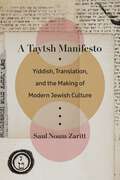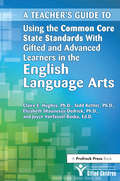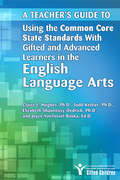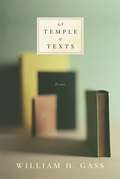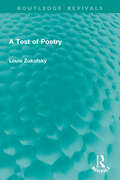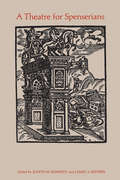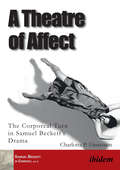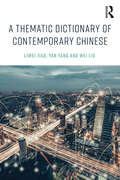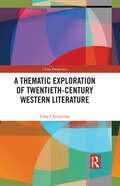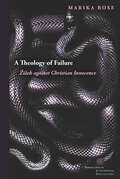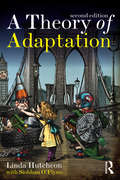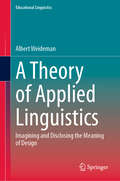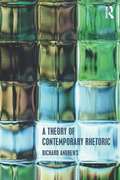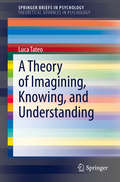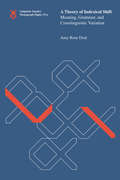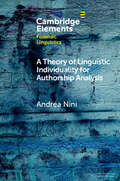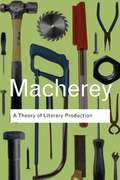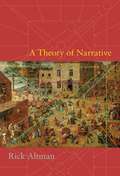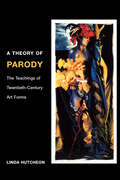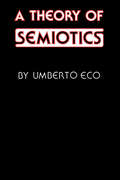- Table View
- List View
A Taytsh Manifesto: Yiddish, Translation, and the Making of Modern Jewish Culture
by Saul Noam ZarittA Taytsh Manifesto calls for a translational paradigm for Yiddish studies and for the study of modern Jewish culture. Saul Noam Zaritt calls for a shift in vocabulary, from Yiddish to taytsh, in order to promote reading strategies that account for the ways texts named as Jewish move between languages and cultures. Yiddish, a moniker that became dominant only in the early twentieth century, means “Jewish” and thus marks the language with a single identity: of and for a Jewish collective. In contrast, this book calls attention to an earlier and, at one time, more common name for the language: taytsh, which initially means “German.” By using the term taytsh, speakers indicated that they were indeed speaking a Germanic language, a language that was not entirely their own. In time, when the word shifted to a verb, taytshn, it came to mean the act of translation. To write or speak in Yiddish is thus to render into taytsh and inhabit the gap between languages.A Taytsh Manifesto highlights the cultural porousness that inheres in taytsh and deploys the term as a paradigm that can be applied to a host of modern Jewish cultural formations. The book reads three corpora in modern Yiddish culture through the lens of translation: Yiddish pulp fiction, also known as shund (trash); the genre of the Yiddish monologue as authored by Sholem Aleichem and other prominent Yiddish writers; and the persistence of Yiddish as a language of vulgarity in contemporary U.S. culture. Together these examples help revise current histories of Yiddish while demonstrating the need for new vocabularies to account for the multidirectionality of Jewish culture. A Taytsh Manifesto develops a model for identifying, in Yiddish and beyond, how cultures intertwine, how they become implicated in world systems and empire, and how they might escape such limiting and oppressive structures.
A Teacher's Guide to Using the Common Core State Standards With Gifted and Advanced Learners in the English/Language Arts
by Elizabeth Shaunessy-Dedrick Todd Kettler National Assoc For Gifted ChildrenA Teacher's Guide to Using the Common Core State Standards With Gifted and Advanced Learners in the English/Language Arts provides teachers and administrators a blueprint for differentiating the Common Core State Standards for English Language Arts for gifted and advanced students through the use of acceleration, depth, complexity, and creativity within and across grade levels. It illustrates the differences between learning experiences for typical and advanced students based on the same standard and provides an array of examples across five of the information text and literary text standards while integrating the other aspects of language arts teaching and learning. The book highlights implementation features, such as classroom management and assessment of student work, that allow teachers to make data-based decisions about instruction for particular students. It also offers guidance to teachers on reading selections for advanced learners at all grade levels.
A Teacher's Guide to Using the Common Core State Standards with Gifted and Advanced Learners in the English/Language Arts
by Joyce Vantassel-Baska Elizabeth Shaunessy-Dedrick Claire Hughes Todd KettlerA Teacher's Guide to Using the Common Core State Standards With Gifted and Advanced Learners in the English/Language Arts provides teachers and administrators a blueprint for differentiating the Common Core State Standards for English Language Arts for gifted and advanced students through the use of acceleration, depth, complexity, and creativity within and across grade levels. It illustrates the differences between learning experiences for typical and advanced students based on the same standard and provides an array of examples across five of the information text and literary text standards while integrating the other aspects of language arts teaching and learning. The book highlights implementation features, such as classroom management and assessment of student work, that allow teachers to make data-based decisions about instruction for particular students. It also offers guidance to teachers on reading selections for advanced learners at all grade levels.
A Teacher's Guide to Writing Workshop Essentials: Time, Choice, Response
by Katherine Bomer Corinne Arens*How can I get started with writing workshop, or refine my workshop? *What are the essential elements of a writing workshop? *How can I create daily structures and routines that support writers? In this foundational guide, Katherine Bomer and Corinne Arens describe the elegant simplicity of a Writing Workshop focused on just three essentials―time, choice, and response. Based on the research-based belief that children learn to write best when we provide a predictable, daily structure for writing, Katherine and Corinne introduce teachers to the rituals and routines of writing workshop and suggest ways to take small, incremental steps toward implementing them. Shared from the viewpoint of two veteran educators who understand the issues and obstacles teachers face day to day, A Teacher’s Guide to Writing Workshop Essentials also serves as a refresher for experienced workshop teachers looking for a chance to refocus, clarify, and extend the work in their practice. If your teaching has become more complicated and more focused on curriculum than on the writers sitting in front of you, if you’re not sure what your students really need to support them as writers, or if you’re just not sure how to get started with Writing Workshop, this guide is for you.
A Temple of Texts: Essays
by William H. GassFrom one of the most admired essayists and novelists at work today: a new collection of essays--his first since Tests of Time, winner of the National Book Critics Circle Award for Criticism. These twenty-five essays speak to the nature and value of writing and to the books that result from a deep commitment to the word. Here is Gass on Rilke and Gertrude Stein; on friends such as Stanley Elkin, Robert Coover, and William Gaddis; and on a company of "healthy dissidents," among them Rabelais, Elias Canetti, John Hawkes, and Gabriel García Márquez. In the title essay, Gass offers an annotated list of the fifty books that have most influenced his thinking and his work and writes about his first reaction to reading each. Among the books: Ludwig Wittgenstein's Tractatus Logico-Philosophicus ("A lightning bolt," Gass writes. "Philosophy was not dead after all. Philosophical ambitions were not extinguished. Philosophical beauty had not fled prose.") . . . Ben Jonson's The Alchemist ("A man after my own heart. He is capable of the simplest lyrical stroke, as bold and direct as a line by Matisse, but he can be complex in a manner that could cast Nabokov in the shade . . . Shakespeare may have been smarter, but he did not know as much.") . . . Gustave Flaubert's letters ("Here I learned--and learned--and learned.") And after reading Malory's Le Morte d'Arthur, Gass writes "I began to eat books like an alien worm."In the concluding essay, "Evil," Gass enlarges upon the themes of artistic quality and cultural values that are central to the books he has considered, many of which seek to reveal the worst in people while admiring what they do best.As Gass writes, "The true alchemists do not change lead into gold, they change the world into words."A Temple of Texts is Gass at his most alchemical.From the Hardcover edition.
A Test of Poetry (Routledge Revivals)
by Louis ZukofskyA Test of Poetry (1932) is a comparative study of poetry from Homer to the twentieth century. By giving several translations of the same passage from Homer, an elegy of Ovid and lines from Herrick which read like an adaptation of Ovid, or a fifteenth century poem about a cock and a recent poem about chickens, and so on, a means for judging the values of poetic writing is established. The book also has a comparative chronological chart, including a summary of critical views.
A Theatre for Spenserians: Papers of the International Spencer Colloquium Fredericton, New Brunswick October 1969
by Judith Kennedy James ReitherThe International Spenser Colloquium, sponsored by St Thomas University and the University of New Brunswick, was held in Fredericton in 1969 to celebrate the four hundredth anniversary of Spenser's first appearance in print in A Theatre for Wordlings. The intention of the colloquium was to honour a great poet for the pleasure and profit his work continues to give and to promote understanding of his poetry through lectures, discussions, and proposals for future lines of exploration. The six original essays on Spenser's poetry contained in this volume were first presented at the colloquium. While there is a central concern with The Faerie Queene, the essays range widely through Spenser's works and treat many aspects of his poetic vision and artistry: his comic vein and his melancholy, his learning and his realism, his grand designs and his richness of detail. In their variety and vivacity the essays amply demonstrate the powerful appeal that Spenser's poetry exerts today and the quality of response it elicits
A Theatre of Affect: The Corporeal Turn in Samuel Beckett's Drama (Samuel Beckett in Company #3)
by Charlotta P. EinarssonCombining phenomenological analysis with dance and performance analysis and affect theory, A Theatre of Affect: The Corporeal Turn in Samuel Beckett's Drama takes stock of the various ways in which the body in Samuel Beckett's drama participates in the affective ecology of performance. Affect is here located in the materiality of the body and discussed in relation to the symbolic significance of, for instance, the effort, direction, speed, or duration of a posture, movement, or gesture. Although the meaning of the body in Beckett's stage-images cannot be mapped onto conventional discursive meanings, the significance of the body's formal modulations is affective in the sense that the import of such changes is immediately recognized and felt as significant by spectators. Beckett's theater of affect therefore is predicated on the infinitesimal stirrings of subliminal meaning-making that continuously shape and create the world in experience.
A Thematic Dictionary of Contemporary Chinese
by Wei Liu Yan Yang Liwei JiaoA Thematic Dictionary of Contemporary Chinese is a unique resource for intermediate to advanced students of Chinese. The dictionary presents 9,000 words organized thematically in 300 different subject areas. These themes cover the vocabulary necessary for daily use and for conducting meaningful conversations with native Chinese speakers on a variety of topics, from politics to business, and from hobbies to education. Each vocabulary item is annotated with the most frequent collocations allowing learners to improve their fluency by storing new vocabulary in larger linguistic units. Cultural and linguistic tips enable learners to grasp the vocabulary more effectively and increase their awareness of Chinese culture embedded in the language. Review exercises are provided throughout to ensure learners have ample opportunity to practice the new material. This is a great resource for both independent study and classroom use and will be of interest to students and teachers of Chinese alike. For further understanding of Chinese expressions, students are encouraged to read 500 Common Chinese Proverbs and Colloquial Expressions and 500 Common Chinese Idioms.
A Thematic Exploration of Twentieth-Century Western Literature (China Perspectives)
by Jiang ChengyongThe twentieth century witnessed dramatic changes in terms of the structure of society, economics, politics, science and technology, driving a change in western literature from traditional to modern: old value systems were shattered; writing approaches and aesthetics changed; writers began to explore the psychological world and expand the discussion of man and modern civilization. This title takes classic literature by European and American authors of the twentieth-century as research objects in order to comprehensively explore their thoughts, values, aesthetics and narratives. Six major themes are used as units for analysis—existential meaning, self-identity, war and human nature, growing confusion, love and marriage, and anti-Utopia. The authors argue that the six themes extend the themes of traditional literature and epitomize the unique characteristics of twentieth-century western literature. The book will be of interest to students and scholars of literature, especially Western literature and twentieth-century literature.
A Theology of Failure: Žižek against Christian Innocence (Perspectives in Continental Philosophy)
by Marika RoseEveryone agrees that theology has failed; but the question of how to understand and respond to this failure is complex and contested. Against both the radical orthodox attempt to return to a time before the theology’s failure and the deconstructive theological attempt to open theology up to the hope of a future beyond failure, Rose proposes an account of Christian identity as constituted by, not despite, failure. Understanding failure as central to theology opens up new possibilities for confronting Christianity’s violent and kyriarchal history and abandoning the attempt to discover a pure Christ outside of the grotesque materiality of the church.The Christian mystical tradition begins with Dionysius the Areopagite’s uncomfortable but productive conjunction of Christian theology and Neoplatonism. The tensions generated by this are central to Dionysius’s legacy, visible not only in subsequent theological thought but also in much twentieth century continental philosophy as it seeks to disentangle itself from its Christian ancestry. A Theology of Failure shows how the work of Slavoj Žižek represents an attempt to repeat the original move of Christian mystical theology, bringing together the themes of language, desire, and transcendence not with Neoplatonism but with a materialist account of the world. Tracing these themes through the work of Dionysius and Derrida and through contemporary debates about the gift, violence, and revolution, this book offers a critical theological engagement with Žižek's account of social and political transformation, showing how Žižek's work makes possible a materialist reading of apophatic theology and Christian identity.
A Theology of Justice in Exodus (Siphrut)
by Nathan BillsThis book traces the theme of justice throughout the narrative of Exodus in order to explicate how yhwh’s reclamation of Israel for service-worship reveals a distinct theological ethic of justice grounded in yhwh’s character and Israel’s calling within yhwh’s creational agenda.Adopting a synchronic, text-immanent interpretive strategy that focuses on canonical and inner-biblical connections, Nathan Bills identifies two overlapping motifs that illuminate the theme of justice in Exodus. First, Bills considers the importance of Israel’s creation traditions for grounding Exodus’s theology of justice. Reading Exodus against the backdrop of creation theology and as a continuation of the plot of Genesis, Bills shows that the ethical disposition of justice imprinted on Israel in Exodus is an application of yhwh’s creational agenda of justice. Second, Bills identifies an educational agenda woven throughout the text. The narrative gives heightened attention to the way yhwh catechizes Israel in what it means to be the particular beneficiary and creational emissary of yhwh’s justice. These interpretative lenses of creation theology and pedagogy help to explain why Israel’s salvation and shaping embody a programmatic applicability of yhwh’s justice for the wider world.This volume will be of substantial interest to divinity students and religious professionals interested in the themes of exodus, exile, and return.
A Theology of Justice in Exodus (Siphrut: Literature and Theology of the Hebrew Scriptures #26)
by Nathan BillsThis book traces the theme of justice throughout the narrative of Exodus in order to explicate how yhwh’s reclamation of Israel for service-worship reveals a distinct theological ethic of justice grounded in yhwh’s character and Israel’s calling within yhwh’s creational agenda.Adopting a synchronic, text-immanent interpretive strategy that focuses on canonical and inner-biblical connections, Nathan Bills identifies two overlapping motifs that illuminate the theme of justice in Exodus. First, Bills considers the importance of Israel’s creation traditions for grounding Exodus’s theology of justice. Reading Exodus against the backdrop of creation theology and as a continuation of the plot of Genesis, Bills shows that the ethical disposition of justice imprinted on Israel in Exodus is an application of yhwh’s creational agenda of justice. Second, Bills identifies an educational agenda woven throughout the text. The narrative gives heightened attention to the way yhwh catechizes Israel in what it means to be the particular beneficiary and creational emissary of yhwh’s justice. These interpretative lenses of creation theology and pedagogy help to explain why Israel’s salvation and shaping embody a programmatic applicability of yhwh’s justice for the wider world.This volume will be of substantial interest to divinity students and religious professionals interested in the themes of exodus, exile, and return.
A Theory of Adaptation
by Linda HutcheonA Theory of Adaptation explores the continuous development of creative adaptation, and argues that the practice of adapting is central to the story-telling imagination. Linda Hutcheon develops a theory of adaptation through a range of media, from film and opera, to video games, pop music and theme parks, analysing the breadth, scope and creative possibilities within each. This new edition is supplemented by a new preface from the author, discussing both new adaptive forms/platforms and recent critical developments in the study of adaptation.? It also features an illuminating new epilogue from Siobhan O’Flynn, focusing on adaptation in the context of digital media. She considers the impact of transmedia practices and properties on the form and practice of adaptation, as well as studying the extension of game narrative across media platforms, fan-based adaptation (from Twitter and Facebook to home movies), and the adaptation of books to digital formats. A Theory of Adaptation is the ideal guide to this ever evolving field of study and is essential reading for anyone interested in adaptation in the context of literary and media studies.
A Theory of Applied Linguistics: Ιmagining and Disclosing the Meaning of Design (Educational Linguistics #65)
by Albert WeidemanThis book adopts as conceptual focus the technical mode of experience, exploring this characteristic mode of design as the angle from which the discipline of applied linguistics takes its cue. What makes applied linguistic concept formation possible? A number of elementary concepts and ideas are so basic to the discipline that they can neither be ignored nor avoided. These ‘primitives’ are identified by examining the connections among the technical and other modalities, such as the spatial, the physical, the social, economic, aesthetic, juridical and the ethical. A theory of applied linguistics must be robust enough to do justice to different modernist and postmodernist paradigms operating in the discipline, systematically identifying and assessing their strengths and blind spots. The book offers a response to the question of the usefulness of theory. The principles of design revealed in the theoretical analysis are given shape in developing imaginative language interventions to solve vexing language problems not for the sake of theory, but for the benefit of those affected. The book is intended for use both as a reference and as a comprehensive, unifying perspective of what the field is, by scholars in applied linguistics and related fields (TESOL, ESL, ESP, EAP, SLA studies, language assessment and testing, language policy development), by postgraduate students or those who teach or study applied linguistics.
A Theory of Contemporary Rhetoric
by Richard AndrewsA Theory of Contemporary Rhetoric describes, explains, and argues the overarching theory of contemporary rhetoric. This current view of rhetoric brings together themes in the communication arts, including political literary criticism; bi- and multi-lingualism; multimodality; framing as an artistic and sociological device for composition and interpretation; literacy in the digital age; and the division between fiction and ‘non-fiction’ in language/literature studies. Chapters explore the implications of rhetoric for particular aspects of the field. Discussions throughout the book provide illustrations that ground the material in practice. As an overarching theory in the communication arts, rhetoric is elegant as a theoretical solution and simple as a practical one. It asks such questions as who is speaking/writing/composing? to whom? why? what is being conveyed? and how is it being conveyed? Acknowledging the dirth of recent works addressing the theory of rhetoric, this book aims to fill the existing theoretical gap and at the same time move the field of language/literature studies forward into new territory. It provides the keynote theoretical guide for a generation of teachers, teacher educators and researchers in the fields of English as a subject; English as a second, foreign or additional language; and language study in general.
A Theory of History (Routledge Library Editions: Historiography)
by Agnes HellerThis radical analysis of the role and importance of historiography interprets the philosophy and theory of history on the basis of historicity as a human condition. The book examins the norms and methods of historiography from a philosophical point of view, but rejects generalisations tht the philosophy of history can provide all the answers to contemporary problems. Instead it outlines a feasible theory of history which is still radical enough to apply to all social structures.
A Theory of Imagining, Knowing, and Understanding (SpringerBriefs in Psychology)
by Luca TateoThis is a book about imaginative work and its relationship with the construction of knowledge. It is fully acknowledged by epistemologists that imagination is not something opposed to rationality; it is not mere fantasy opposed to intellect. In philosophy and cognitive sciences, imagination is generally “delimiting not much more than the mental ability to interact cognitively with things that are not now present via the senses.” (Stuart, 2017, p. 11) For centuries, scholars and poets have wondered where this capability could come from, whether it is inspired by divinity or it is a peculiar feature of human mind (Tateo, 2017b). The omnipresence of imaginative work in both every day and highly specialized human activities requires a profoundly radical understanding of this phenomenon. We need to work imaginatively in order to achieve knowledge, thus imagination must be something more than a mere flight of fantasy. Considering different stories in the field of scientific endeavor, I will try to propose the idea that the imaginative process is fundamental higher mental function that concurs in our experiencing, knowing and understanding the world we are part of. This book is thus about a theoretical idea of imagining as constant part of the complex whole we call the human psyche. It is a story of human beings striving not only for knowledge and exploration but also striving for imagining possibilities.
A Theory of Indexical Shift: Meaning, Grammar, and Crosslinguistic Variation (Linguistic Inquiry Monographs #82)
by Amy Rose DealA comprehensive overview of the semantics and syntax of indexical shift that develops a constrained typology of the phenomenon across languages.The phenomenon of indexical shift--whereby indexicals embedded in speech or attitude reports draw their meaning from an attitude event rather than the utterance context--has been reported in languages spanning five continents and at least ten language families. In this book, Amy Rose Deal offers a comprehensive overview of the semantics and syntax of indexical shift and develops a constrained typology of the phenomenon across languages--a picture of variation that is both rich enough to capture the known facts and restrictive enough to make predictions about currently unknown data points.
A Theory of Linguistic Individuality for Authorship Analysis (Elements in Forensic Linguistics)
by Andrea NiniAuthorship analysis is the process of determining who produced a questioned text by language analysis. Although there has been significant success in the performance of computational methods to solve this problem in recent years, these are often methods that are not amenable to interpretation. Authorship analysis is in all effects an area of computer science with very little linguistics or cognitive science. This Element introduces a Theory of Linguistic Individuality that, starting from basic notions of cognitive linguistics, establishes a formal framework for the mathematical modelling of language processing that is then applied to three computational experiments, including using the likelihood ratio framework. The results propose new avenues of research and a change of perspective in the way authorship analysis is currently carried out.
A Theory of Literary Production
by Pierre MachereyWho is more important: the reader, or the writer? Originally published in French in 1966, Pierre Macherey’s first and most famous work, A Theory of Literary Production dared to challenge perceived wisdom, and quickly established him as a pivotal figure in literary theory. The reissue of this work as a Routledge Classic brings some radical ideas to a new audience, and argues persuasively for a totally new way of reading. As such, it is an essential work for anyone interested in the development of literary theory.
A Theory of Narrative
by Rick AltmanNarrative is a powerful element of human culture, storing and sharing the cherished parts of our personal memories and giving structure to our laws, entertainment, and history. We experience narrative in words, pictures, and film, yet regardless of how the tale is told, story remains independent from the media that makes it concrete. Narrative follows humans wherever they travel and adapts readily to new forms of communication. Constantly evolving and always up-to-date, narrative is a necessary strategy of human expression and a fundamental component of human identity.In order to understand human interaction, award-winning scholar Rick Altman launches a close study of narrative's nature, its variation in different contexts, and the method through which it makes meaning. Altman's approach breaks away from traditional forms of analysis, identifying three basic strategies: single-focus, dual-focus, and multiple-focus. Unpacking an intentionally diverse selection of texts, Altman demonstrates how these strategies function in context and illustrates their theoretical and practical applications in terms of textual analysis, literary and film history, social organization, religion, and politics. He employs inventive terminology and precise analytical methods throughout his groundbreaking work, making this volume ideal for teaching literary and film theory and for exploring the anatomy of narrative on a more general level.
A Theory of Parody: The Teachings of Twentieth-Century Art Forms
by Linda HutcheonIn this major study of a flexible and multifaceted mode of expression, Linda Hutcheon looks at works of modern literature, visual art, music, film, theater, and architecture to arrive at a comprehensive assessment of what parody is and what it does. Hutcheon identifies parody as one of the major forms of modern self-reflexivity, one that marks the intersection of invention and critique and offers an important mode of coming to terms with the texts and discourses of the past. Looking at works as diverse as Tom Stoppard's Rosenkrantz and Guildenstern Are Dead, Brian de Palma's Dressed to Kill, Woody Allen's Zelig, Karlheinz Stockhausen's Hymnen, James Joyce's Ulysses, and Magritte's This Is Not a Pipe, Hutcheon discusses the remarkable range of intent in modern parody while distinguishing it from pastiche, burlesque, travesty, and satire. She shows how parody, through ironic playing with multiple conventions, combines creative expression with critical commentary. Its productive-creative approach to tradition results in a modern recoding that establishes difference at the heart of similarity. In a new introduction, Hutcheon discusses why parody continues to fascinate her and why it is commonly viewed as suspect-–for being either too ideologically shifty or too much of a threat to the ownership of intellectual and creative property.
A Theory of Proculturation: Development of the self through intercultural communication (SpringerBriefs in Psychology)
by Vladimer Lado GamsakhurdiaIn each connection with new cultural contexts a new hybrid state of cultural adaptation is constructed enabling people to adjust to new conditions by creating innovative solutions for the self. This book aims to provide a brief presentation of innovative cultural psychological theory of proculturation reflecting and oriented on the understanding of semiotic and developmental dynamics of higher mental phenomena while engaging alien signs through intercultural communication. The exploration and theoretical understanding of developmental dynamics (such as self and identity construction) of people who live in immigration or multicultural, or even multi-ethnic societies, the research builds its new focus in contrasts with the acculturation theories currently present in social psychology. The theory of proculturation has been built in opposition to cross-cultural psychological theories as well as mainstream theories of acculturation research dominated by bidimensional theoretical models. Instead, this theory is constructed based on theoretical explorations which are rooted in cultural semiotics and developmental psychological paradigm on human psychology.
A Theory of Semiotics (Advances in Semiotics)
by Umberto Eco" . . . the greatest contribution to [semiotics] since the pioneering work of C. S. Peirce and Charles Morris." —Journal of Aesthetics and Art Criticism" . . . draws on philosophy, linguistics, sociology, anthropology and aesthetics and refers to a wide range of scholarship . . . raises many fascinating questions." —Language in Society" . . . a major contribution to the field of semiotic studies." —Robert Scholes, Journal of Aesthetics and Art Criticism" . . . the most significant text on the subject published in the English language that I know of." —Arthur Asa Berger, Journal of CommunicationEco's treatment demonstrates his mastery of the field of semiotics. It focuses on the twin problems of the doctrine of signs—communication and signification—and offers a highly original theory of sign production, including a carefully wrought typology of signs and modes of production.
